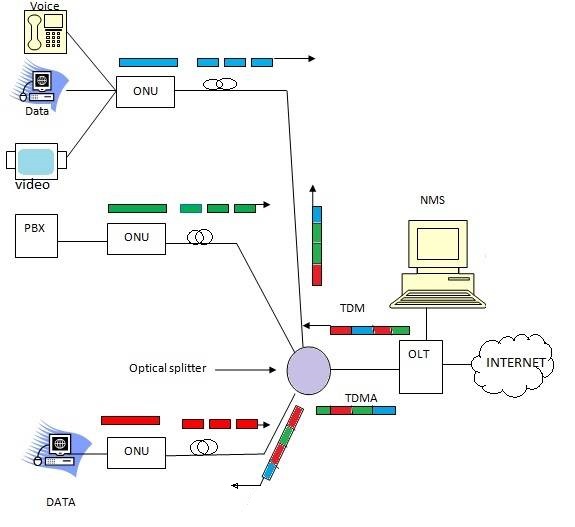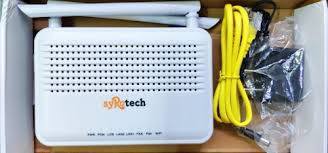What is FTTH ( Fibre to the Home)
Fiber to the home (FTTH) is the delivery of a communications signal over optical fiber from the operator’s switching equipment all the way to a home or business, thereby replacing existing copper infrastructure such as telephone wires and coaxial cable. Fiber to the home is a relatively new and fast growing method of providing vastly higher bandwidth to consumers and businesses, and thereby enabling more robust video, internet and voice services.
Connecting homes directly to fiber optic cable enables enormous improvements in the bandwidth that can be provided to consumers. Current fiber optic technology can provide two-way transmission speeds of up to 500 megabits per second. Further, as cable modem and DSL providers are struggling to squeeze increments of higher bandwidth out of their technologies, ongoing improvements in fiber optic equipment are constantly increasing available bandwidth without having to change the fiber.

PON
PON ( Passive Optical Network) takes advantage of wavelength division multiplexing (WDM), which means using one wavelength for downstream traffic and one wavelength for upstream traffic on a single fiber.
EPON
EPON stands for Ethernet passive optical network. EPON uses Ethernet packets instead of ATM (Asynchronous Transfer Mode) cells. EPON also uses Internet Protocol (IP) to carry data, voice, and video data. It generally delivers 1G symmetrical bandwidth, which makes it a popular choice.
EPON provides:
- Data rates of 1 Gbps upstream and downstream
- Access to data like Internet, voice, and video service.
- Usable bandwidth: 1 Gbps upstream and downstream
- Reach: Up to 64 ONUs per PON Port
- Subscriber cost: Lower than GPON
- Encryption: Upstream and downstream
GPON
GPON stands for Gigabit Ethernet passive optical network. GPON uses ATM for voice, Ethernet for data, and proprietary encapsulation for voice. It offers faster Gbps than EPON on downstream and upstream bandwidths.
GPON provides:
- Up to 2.5 Gbps
- Usable bandwidth: Up to 2.5 Gbps downstream and upstream
- Reach: Up to 128 ONUs
- Subscriber cost: Higher than EPON
- Encryption: Downstream only
SY-GPON-1110-WDONT Configuration

| About | Details |
|---|---|
| Company | syRotech Networks Pvt Ltd |
| Description | Subscriber End Equipment |
| Product Name | G/EPON ONT |
| Default IP Address to open Equipment | 192.168.1.1 |
| User ID | admin |
| Default password | Syro@43210$ |
| Product Mode | SY-GPON-1110-WDONT |
Syrotech ONU Configuration Steps for BSNL
- Open ONT using IP address 192.168.1.1 in your browser
- Enter syRotech default user id as admin and default password as Syro@43210$ to login to ONT
Internet Configuration
- Hover to Network
- Click Internet Connection and select the following
- Connection Name: 1_Internet_R_VII
- Mode: Route
- IP Protocol Mode: Ipv4
- Select PPPoE
- Enable NAT, VAN
- Enter FTTH Username and Password provided by ISP
- Enter Service Name: BSNL
- Enable Port Binding [Port_1, Port_2, WLAN(SSID1)]
WiFi Configuration
- Hover to Network
- Click WLAN
- WLAN Basic
- Band: 2.4Ghz
- Mode: AP (Your circle)
- SSID: Enter your WiFi Name
- Select WMM, SGI
- WLAN Advanced
- Click Off under Different SSID isolation > Apply Changes
- WLAN Security
- Select SSID Type
- Encryption (WPA2 Mixed)
- Authentication Mode as Personal (pre-shared key)
- Select TKIP under WPA2 Cipher Suite > AES under WPA2 Cipher Suite
- 86400 as Group Key update timer
- Select Passphrase under Pre-shared key format
- Enter password under pre-shared key
- Apply Changes
Voice Configuration
- Go to Application
- Click VOIP Configuration
- Select Soft Switch SIP under Server Type
- Enter the values given by your ISP (Primary and Secondary SIP Register and Proxy details)
- Provide your phone number starting with 91 in Account Number and Account Name > Enter password > Click Save/Apply
HG323 ONU Configuration For BSNL FTTH

HG323 XPON ONT Configuration at 192.168.1.1 for BSNL FTTH Voice & Internet
- Login to HG323 XPON ONT in any browser with url 192.168.1.1
- Enter username and password
username is admin and default password is stdONU101
Go to Management > Device Management > Restore default > Restore Factory default
Click Network > Internet > Delete
Check Status > Wan Connection info >
WAN info status enabled means, you are ready to browse the internet.
Click Network > Internet (Add New Connection for Internet)
Mode : Route,
IP Protocol Mode : Ipv4, and select PPPoE,
Enable NAT : Select radio button
Enable Vlan : Enable by select,
Vlan id : Submit the ID provided by BSNL,
Username : Enter BSNL allocated FTTH username followed by @ftth.bsnl.in
Password : password (default)
Service Name : BSNL or which you want,
IP Address: Provide your BSNL allocated IP address,
Port binding : Enable Port 1, Port2 and WLAN (SSID1) by selecting in each box
Click Save- Again Click Network > Internet for Voice Configuration
Connection name : Add new wan connection,
Mode : Route,
IP Protocol Mode : Ipv4, and select Static,
Enable Vlan : Enable by select,
Vlan id : 1830,
Provide your BSNL allocated IP address, Subnet Mask, Default Gateway, DNS1, DNS2, provided by BSNL
Service Mode : Voice
Click Save - Click Application
Enable all the services(ftp, h323, rtsp,ipsec, sip, pptp) in ALG configuration
Save/Apply - Click Application > VOIP
SIP registered address : xx.ftthvoip.bsnl.in (first 5 to be filled as xx.ftth.bsnlvoip.bsnl.in)
Select and Enable Outbound Proxy,
Enable Line 1 and enter Account name, Account number, Account password with allotted BSNL FTTH phone number starting with 91 starting by removing 0
Click Save/Apply - Click Status
WAN Information info for both Voice and Internet facilities are enabled or not.
